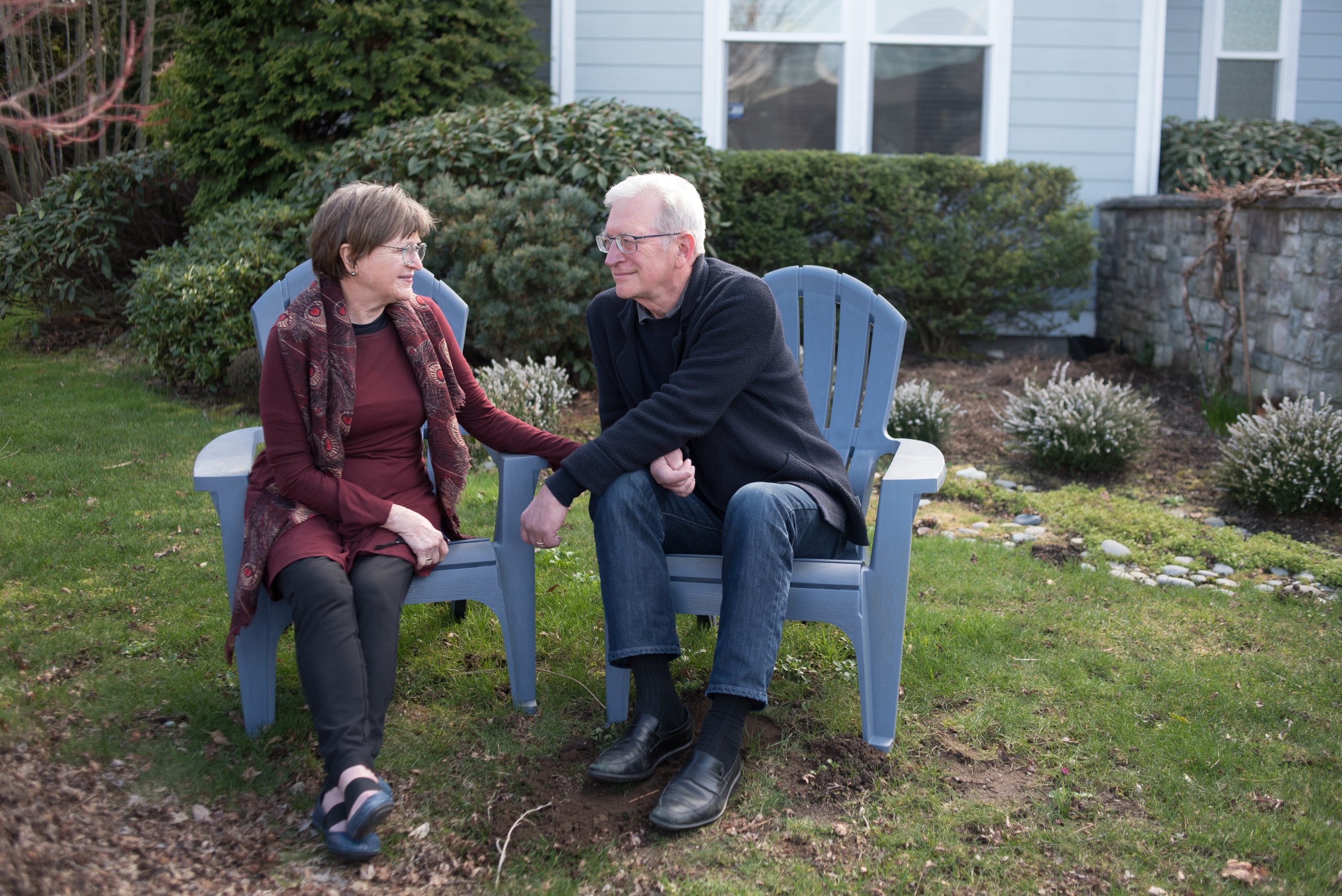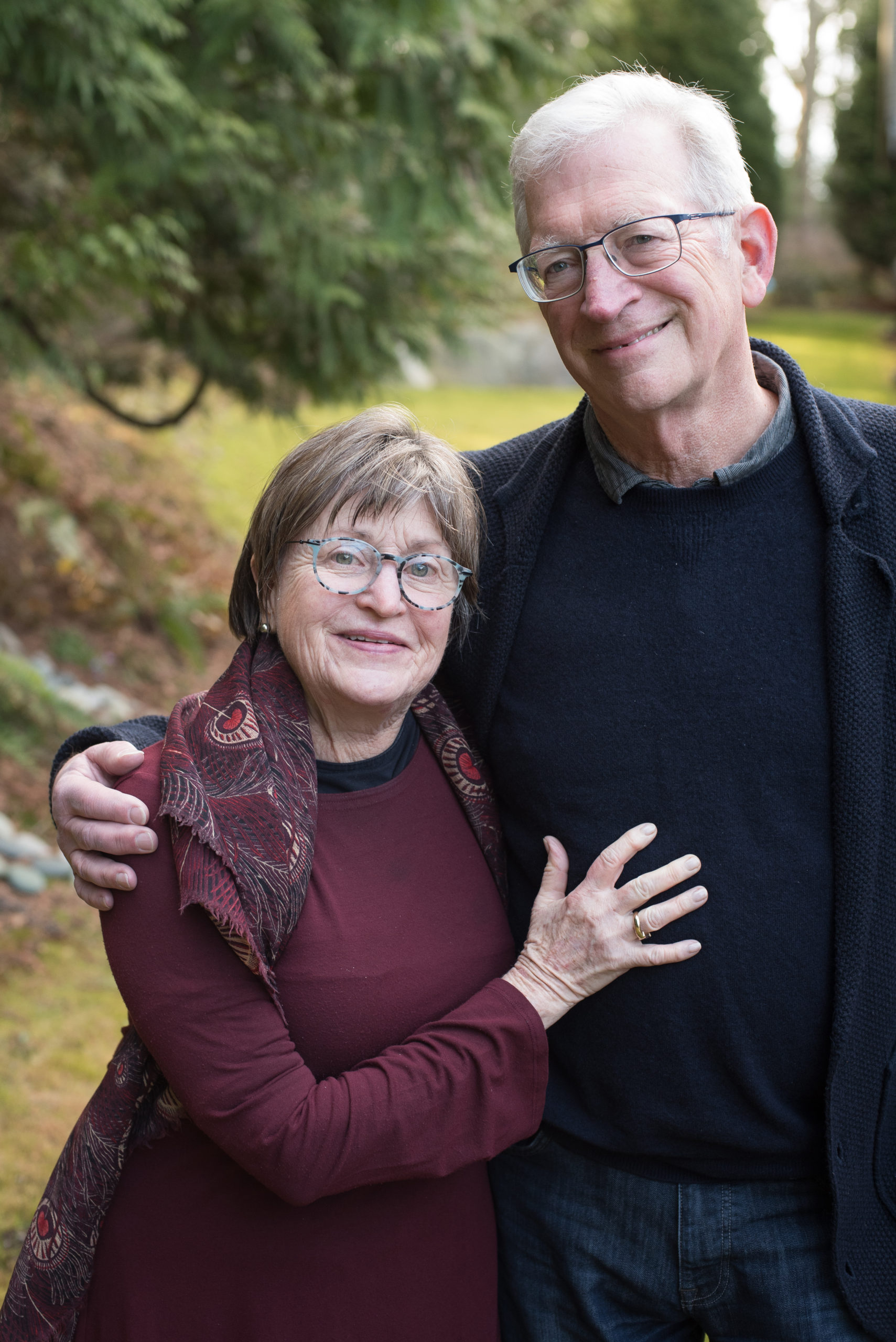Halfway There

How Professor Joan Connell has tackled online-learning and isolation.
By Jaya Flanary // Photos by Oliver Hamlin
Campus is desolate besides a few students meandering around. It is late February and cold, but sunny nonetheless. I see Professor Joan Connell, my advisor for Klipsun magazine, sitting cross-legged outside the Communications Facility Building. She is so quaint.
Joan is wearing a black beret, a scarf, tights and an N95 mask. She looks dressed for an occasion. I do not.
I have been meeting with her on Zoom consistently since December when I was hired as Klipsun’s Editor-in-Chief. I am so used to Joan’s Zoom appearance — a floating head whose eyes bounce around between screens — that I forgot how petite she is.
We walk around the field until she is convinced she forgot her hat. I don’t ask if she means the hat on her head — if Joan says she forgot her hat, she must have. Soon, she realizes it’s on her head, giggling. We keep walking, and suddenly, I’m on Joan Connell’s tour of Western Washington University’s famous sculpture art.
At the farthest point of north campus, near Old Main, Joan searches for 2019’s sculpture addition: Sarah Sze’s “Split Stone (Northwest).” The stones glimmer in the sunlight and Joan crouches in, feeling them with her delicate 73-year-old hands.
Joan knows almost every artist’s name. We stop at Isamu Noguchi’s “Skyviewing Sculpture.” I have to go inside to get the full effect, per Joan’s request. I have walked campus endless times and have never stepped foot inside this 1969 gem, but when I do, I see how its three-dimensional shape blocks out everything but the blue sky.
When the spontaneous tour wraps up, we sit down and catch up on one of the most interesting years of our lives.
A little over one year ago, WWU cancelled in-person classes due to COVID-19. Professors were expected to switch over to online-teaching right before finals week of winter quarter.
One of Joan’s concerns teaching online was how students felt about being on camera, so she originally offered it as an option in her newswriting class. “That was a mistake,” she says, laughing. “Because then I ended up talking to 14 blank squares, and that was hard.”
Despite the challenges, she received support from the school’s technology staff. She used Canvas and Zoom, but refused to pre-record lectures, which she finds ineffective. Instead, she uses asynchronous Google Slides that incorporate readings and study questions. She treats synchronous classes like all-class discussions, and takes breaks in the middle which allow students to stretch, grab a snack or do whatever they need to do to make online learning more bearable.
“Through the summer and into the fall, people got much more sophisticated,” Joan says. “They started staging their rooms and being more comfortable on camera.”
One of Joan’s classes, Mass Media Ethics, is full of students who Joan says are “just brilliant.” In their research papers, students are addressing vaccine equity, the ethical risks and reward of narrative journalism, making Facebook a better global citizen and more.
“They’re absolutely stepping up and embracing all of the real issues that are confronting us,” Joan says. “And, doing it brilliantly.”
Though she is retired from a long and successful career in journalism, Joan continues teaching college journalism courses, as well as advising for Klipsun magazine. After a quarter of meeting online, I am delighted to see Joan face-to-face for the first time in over a year.
“Klipsun this quarter has been one of the best I’ve ever taught, just because of the enhanced awareness of who we all are at this moment and what we’re facing,” Joan says. “Jan. 6 could have been the end of America.”
My chest is tight, as I remember my conversation with Joan that dreadful day. The attack on the U.S. Capitol occurred on our first day of Klipsun’s Zoom class. I was nervous to lead my very first meeting — and even more nervous because the breaking news loomed overhead on my TV.
I remember Joan was distracted that day, like we all were. She seemed somber through my screen. She reminded us all: we are witnessing history.
“I’ve lived through a lot. I’ve seen a lot,” Joan says. “But I’ve never lived through such a series of crises, in a very short period of time.”
Recently, Joan received her first Moderna COVID-19 vaccine, which is part of the reason she felt safe to meet with me. This interview is her first social engagement since March of last year, besides a few socially-distanced walks with her neighbor. She adjusts her mask constantly, ensuring it’s above the bridge of her nose.
“I’m halfway there; I’m almost immune,” she says. “So maybe my life will change.”
Joan feels fortunate to have her health, but is struggling with not seeing her family. She hasn’t seen her five grandchildren since Christmas of 2019. Her family is blended with her husband’s, who is also a WWU journalism professor. I had the pleasure of taking Dean Wright’s ethics class, and writing about his career back when I could sit down with another human in the library and talk.
I took sitting and talking for granted, especially as a journalist. Joan and I agree that we’re thankful for technology during mandatory isolation.
While I’m isolated with roommates minutes from campus, Joan and Dean live in Birch Bay, Washington, about 25 miles from WWU. In addition to teaching, they co-own a mom-and-pop global media consulting company, Connell Wright Media. Dean does consulting with news organizations in China, where he usually travels to many times a year. Since the pandemic, Dean remains at home.

The couple shares a ring light for what Joan calls their “studio time,” or online-teaching. “I broadcast from our bedroom and he broadcasts from his lair upstairs,” she says.
I admit to Joan I’ve become a workaholic, unable to separate work from my personal life, now that it all takes place in the same room. She is more self-disciplined, because of her experience in the media industry where she always put her job first and her personal life second. She takes breaks in the afternoon for at least two hours to walk in the woods or near the water.
“I have made friends with a lot of trees,” she says, smiling.
Joan loves nature as much as she loves sculpture art. She also used to be a religion and ethics editor, so she merged these interests and designed a course called Religion Ethics in Nature. She planned to teach in the Arboretum, but wound up teaching it from her bedroom.
She calls it her “biggest intellectual wonderfulness of this time.”
Her students studied Thomas Berry, a famous cultural historian with a mystical view of nature who believes humans can repair our relationship with nature by learning from Indigenous cultures. In her class, Joan made connections to the late Lummi Tribe Hereditary Chief Bill James and his stories about how “we’re all part of the same family.”
In the course, she encouraged her students to practice the Japanese art of forest bathing, or going into nature — disconnected from the technology we are grateful for — to become intimate with the trees, wind and stars. Their homework, amid the pandemic, was to go outside and just enjoy nature in its purest form.
“It’s right here, right in our backyard. And we’re so oblivious to it,” Joan says. “The richness of that experience … I don’t know if that would have happened if we didn’t have this COVID thing.”
Twice a week, when she’s not teaching or making friends with trees, Joan is perfecting the art of French country bread. Dean is cooking more. They garden together, and work on their French by watching French TV. Dean plans trips they hope to eventually take.
I envy their marriage, and have since I found out about it. I know they followed each other around the country each time one of them got a job opportunity.
We start to chat about the future and get carried away in Klipsun-related conversation and what I’ll do after graduation. Next thing I know it’s been two hours since our art walk, and I realize I should let Joan go. We part ways at Bruce Nauman’s “Stadium Piece,” which I only know as the stairs to nowhere.
I want to hug her, but I can’t.
